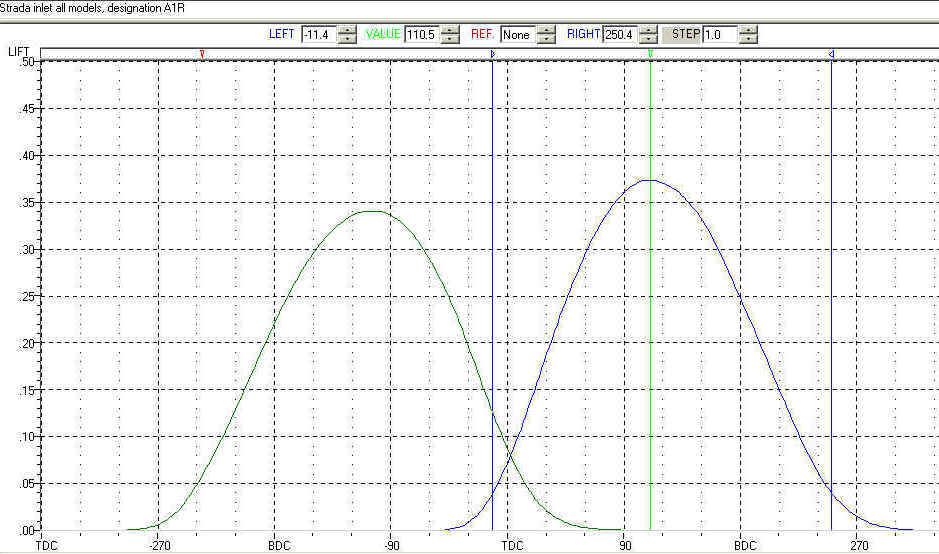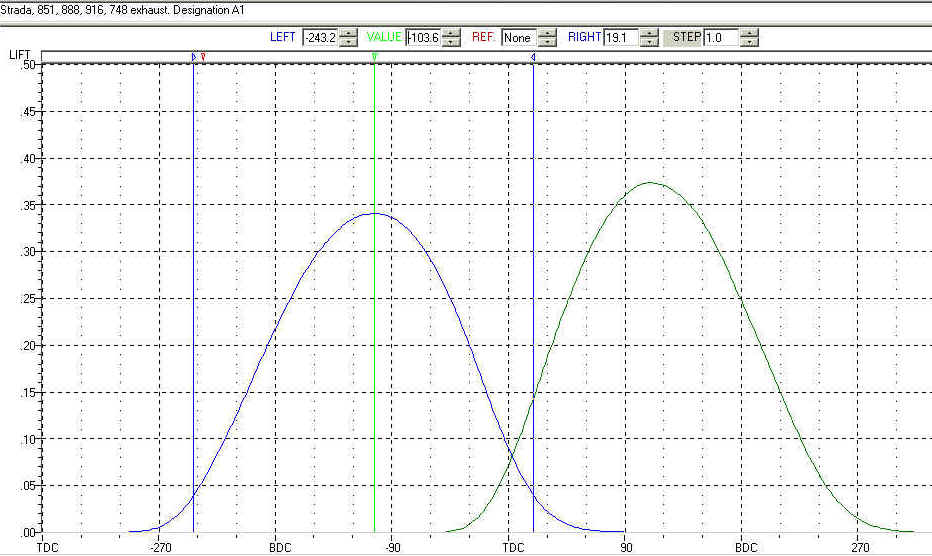
Ducati 4-Valve Strada Cams
Ducati has used the same cams in all of the Strada models, at least since 1990. Probably before that.
The lift and duration numbers have been the same from 1990 until the 2000 996. The Strada cams have always been marked 'A1'.
When Ducati started using electronic tachs on the 916 the horizontal inlet cam was changed to eliminate the tach drive extension. The designation of the horizontal inlet cam changed to A1R, (along with a part part number change) but all three of the other cams are still marked A1 and kept their old part numbers.
The chart below shows the Strada cams by lift and engine degree.
The blue cursors are set at .040" lift on the inlet. You can see that the timing numbers (above the chart) are within 0.4 degrees of the Ducati specs.
The left cursor is at 11.4 BTDC, the right at 70.4 ABDC, which calculates to 119.5 ATDC as the inlet lobe center.
The green cursor is set at peak lift (actually, I set it at the zero velocity point) and that is at 110.5 ATDC.

The duration of the Strada cams works out to be 261 degrees. That is actually a fairly long cam duration. That would explain why the 916 can make any power at high RPM with such small valve sizes. (Cam/port matching is a big subject in itself.)
If you're willing to accept that inlet closing and max lift are the most important dimensions, then look at this cams if it was symmetrical.
The duration from peak lift to I.C. is 140 degrees. If the cam was symmetrical it would be 280 degrees in duration. Ducati have been able to make a cam that acts like a 280 degree cam, yet limit the overlap for emissions purposes.
I see a fair amount of discussion about advancing the inlet cams to get more conventional Sport-bike cam numbers. If you advance these cams to 105 degree lobe centers based on the 0.040" lift figures, the actual peak lift (which is the functional lobe center) moves to 95 ATDC.
Below is a similar graph with the blue cursors set at the 0.040" lift points of the exhaust lobe. The opening and closing numbers put this at 112.05 degrees. Again the green cursor is set at the peak lift point and that is at 103.6 degrees. The functional lobe center is retarded 8.5 degrees. If the exhaust lobe was symmetrical it would be a 279.2 degree duration cam.
Retard the exhaust cam to an indicated 105 degrees and the actual lobe center is at 96.6 degrees BTDC.

When the Strada cams are set at stock specs there is still enough overlap to not cause a big lose in power. This seems, to me, to be a pretty clever and practical compromise.
One final note. For some reason all of the cams in the 851, 888, 916, 955 4-valves close the inlets at 70 to 72 degrees after BDC. (This includes the SP2 and 3 cams and the 'G' cams.)
I'm not trying to be pedantic or loyal on this subject. On the other hand, I don't feel inclined to re-invent the wheel.
I may be missing some astonishing 'magic' numbers, but the results I've achieved are right in line with those of some very good tuners. At this point I don't feel that I'm cheating my customers.
The most important part of this subject is that FIM does there chip development on engines with the cams set to stock specifications and the good results come from proper fuel/air ratio. By using FIM chips or FIM compatible chips and making small adjustments I can adjust my customers systems and send them down the road without charging them for 'magic'.